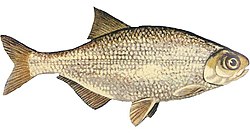Evolution
Osteoglossids are basal teleosts that originated during the Cretaceous, and are placed in the actinopterygian order Osteoglossiformes. The traditionally defined wider family includes several extant species from South America, one from Africa, two from Asia, and two from Australia. [5] The earliest known osteoglossid is Cretophareodus from the middle Campanian of the Dinosaur Park Formation, Canada, but a potentially older genus may be Chanopsis from the Albian of the Democratic Republic of the Congo. [6]
Although currently restricted to freshwater habitats in the tropics, the group was much more widespread during the Cretaceous and Paleogene, with genera known from North America and Europe, including marine taxa such as Brychaetus . An indeterminate marine osteoglossid is known to have inhabited the seas around Greenland in the Early Paleocene, and they later become diverse in marine habitats during the Eocene, with many genera known from Europe. [7] [8]
Modern osteoglossids of both subfamilies have a roughly Gondwanan distribution confined to freshwater habitats. For this reason, it was formerly assumed that extant osteoglossids descend from an ancestor that inhabited the supercontinent of Gondwana during the Mesozoic, which split into different genera following its fragmentation. However, more recent studies have found that many of the closest extinct relatives to extant osteoglossid genera were marine fish, and thus that their current distribution likely originates from marine dispersal between different continents during the Paleogene. Incorporating both extant and extinct osteoglossids, at least four different colonizations of freshwater habitats from marine ones are predicted to have occurred. [4]
This page is based on this
Wikipedia article Text is available under the
CC BY-SA 4.0 license; additional terms may apply.
Images, videos and audio are available under their respective licenses.




